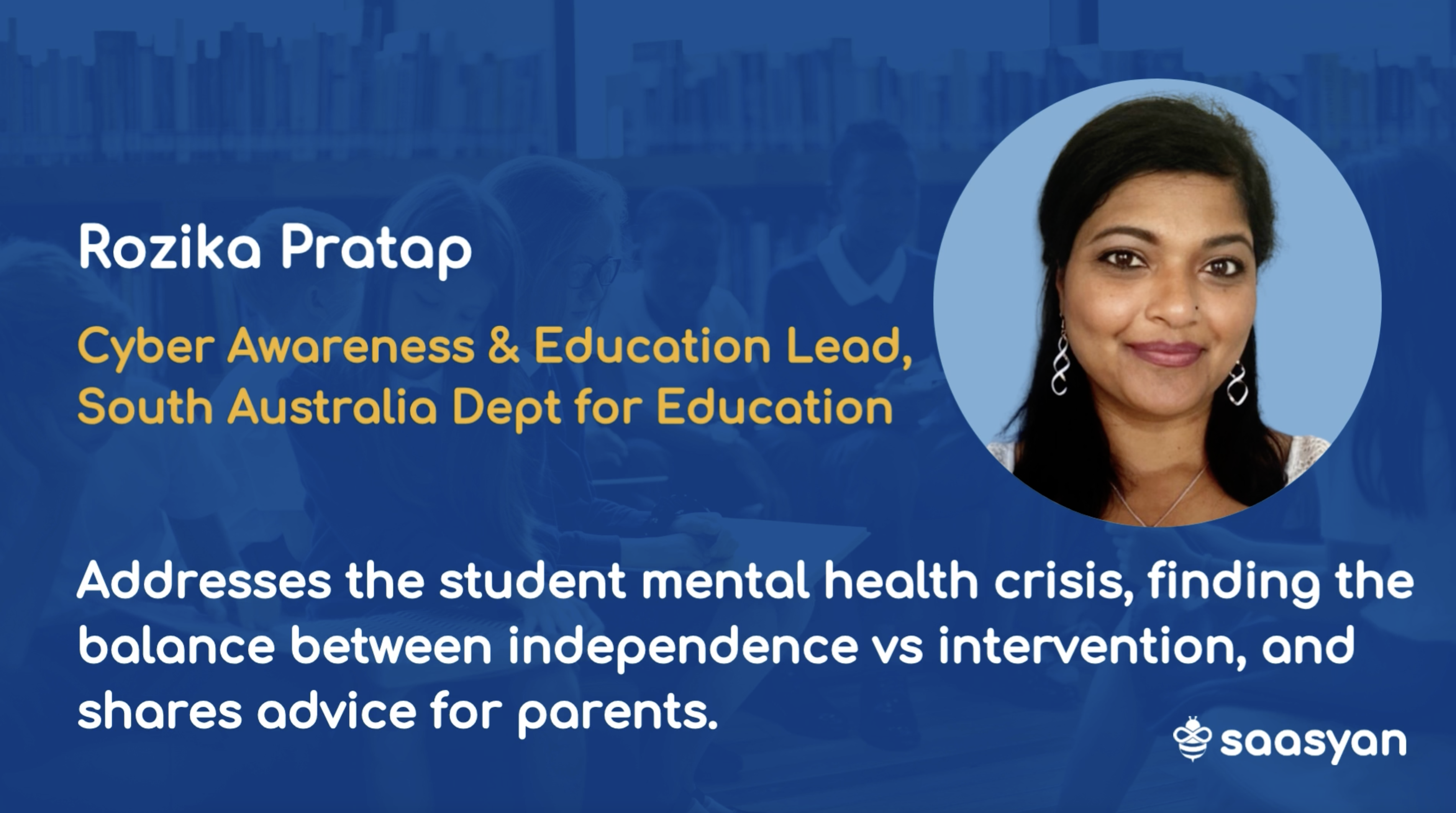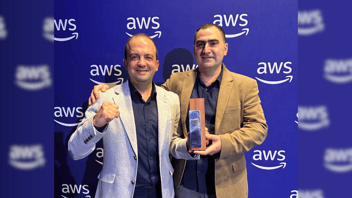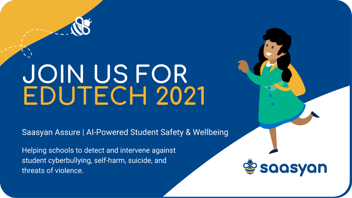Addressing The Student Mental Health Crisis, Advice for Parents and More with Rozika Pratap, Department for Education South Australia

In her role as the Cyber Awareness and Education Lead for the South Australia Department for Education, Rozika Pratap has a unique perspective to add when it comes to student online safety.
In this episode of Saasyan's Wellbeing Wednesday Series, she shares her perspective on the growing student mental health crisis, identifying the balance between offering students the independence they crave with the need to intervene, and her advice for parents.
What are some actions that you have taken to address the growing student mental health crisis?
So I know when I was in a school it was creating that whole of school approach to embedding wellbeing and implementing wellbeing practices and tools. So we created a culture where wellbeing was everyone's responsibility. It wasn't just the wellbeing leaders, it wasn't just the classroom teachers, it was a collective responsibility.
And so there was a little bit of foundation work that was done with our staff, around talking about what behaviour is and understanding that behaviour is actually a response to an emotion, or a need that the child is trying to meet. So it's those conversations and then it was a conscious decision to separate the behaviour from the child.
There's also a real emphasis in our schools of having a break from technology, so we've got the mobile ban now that's across the schools. I know that if schools are using or needing to use it, it's supervised, but there's that conscious again, decision to give students a break from it.
And so now that there's no access to mobiles during the daytime, they're having to re-engage into face to face conversations, relearning how to communicate effectively and hopefully embedding the education piece and thinking hang on, if I'm not comfortable saying this face to face, I really shouldn't be putting it on an online environment.
How do you balance allowing students to have the independence they crave with the need to intervene to ensure digital and physical safety?
First and foremost, any school that I've worked in, we've been really open and transparent that there are systems in place that do monitor what you are doing as a learner in our school environment.
And I think that transparency is so important because it builds that trust. It's saying ‘I can see what you're seeing, but I trust you to do what you're doing, but also know if you make those mistakes, you're making it in the safest place possible and I'm here to kind of support you.’
So that's the messaging that's really important and is one that when we ran our initial training with our school staff, it's something that I made sure was tabled upfront. Just be transparent and honest with your school community that this is something that's being used.
And it's really important to make sure that you build that trust with the student. So whoever is the key person for that student that's doing that search, you know, contextually you need to know who the student is. You need to be aware of what's been happening for them and what support is in place. So for me, if I got that message, it would be depending on the age, so again, high school students you’d feel more confident to be able to go to the student and have that conversation and just start with, ‘hey, I noticed that you were searching this, do you want to tell me about it.’
Mind you, prior to that conversation, I'd make sure I would check with the teachers if that was part of teaching and learning, cause the worst thing you can do is if something is part of teaching and learning is to try and make you know an issue out of something that's not really an issue. And then really letting the student do the talking. Ultimately, our role is to listen and not put words into students mouths.
So it's just creating a space for them to talk and then for us to listen and then consciously creating a culture across the school that embraces technology and the digital realm. And we've seen this certainly with Department for Education here in South Australia with us embracing and developing our own ED-Chat.
So when we had ChatGPT come out a lot of the jurisdictions kind of said ‘nope, we're blocking that,’ whereas the Department for Education went and created their own version, which was safe for our students to use, which is in trial at the moment.
I think what we've done culturally across our schools is to say ‘we're going to embrace this, and we're going to support our students to learn how to use it appropriately.’ So it's that really cultural shift and it's taking on board the ‘Goldilocks Effect’ approach which is creating that optimal balance, just the right balance for that person contextually to be on the digital platform so that we can teach them to become independent and be safe users of the digital platform.
What are 3 things parents can do to support their child's wellbeing?
I think reflecting on myself as a parent, but also as a teacher, and what i've seen out in the community, just being a parent. Like, just be a parent that's present and actively involved in your children's life.
For me, I have children, you know, from 10 to one that's nearly 16. And so I just think it's so important to be their parent and not their best friend. Having the structures in place and boundaries in place that make them feel safe and support them to make mistakes and then teach them that it's ok to make mistakes and what have you learned from your mistake and not rescuing them.
So it's really letting them, self soothe, self regulate themselves to then build resilience. If we do this really well, as our children are younger, as they get older they're able to self regulate themselves, whatever they're dealt with, they're able to tap into those skills they've learned earlier on and they’ll go ‘hang on, it's okay to make mistakes.
I know what I'm feeling and this is how I'm going to get over this and cope with this.’ For me, that ‘being a parent’ and providing that structure is really important.
The other one is talk to your child. Like on a daily basis if you can, whether it's face to face, messages, whatever, but talk to them, stay connected with them because what you're really doing is creating a two way conversation with your child so as they grow and they evolve, they know that there's a baseline, there's a line in the sand, that communication is important. So I think that's super important.
And the third one for me is be open and honest with your feelings because we are role models for our children. It's so important to model all of our small feelings, all of our big feelings.
So you know, ‘I'm feeling this way because...’ and then labelling the feelings, getting them to understand it, so that when they're feeling those feelings and I know my son did this, you know, he’d be like ‘I'm feeling this...’ I said ‘oh that's called jealousy. You're feeling left out? That's called jealousy.’ You know, and six months later, he came back. ‘I'm feeling really jealous.’ And I'm like, ‘Excellent! You labeled your feeling, now that you're feeling that, that's okay.’ Like, normalise that feeling, and how can you get over that feeling?
So I think being an open and honest role model about your feelings is super important. I remember when I was younger, it was that shame was put on the feelings. Whereas now I think there's been a significant shift where we're kind of trying to help label and recognise feelings.






